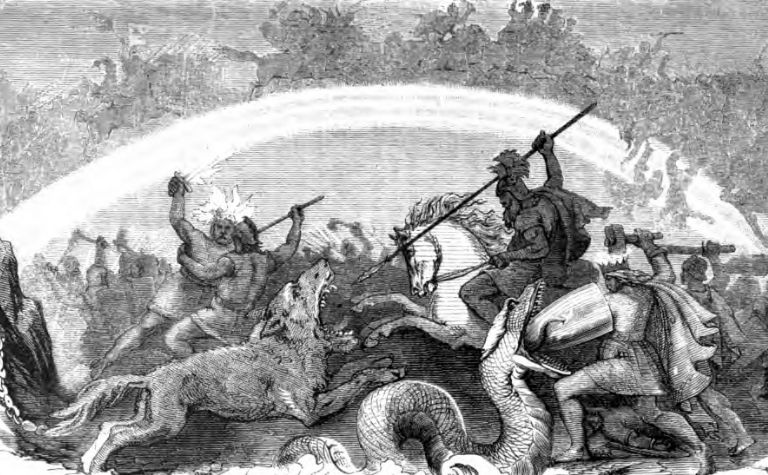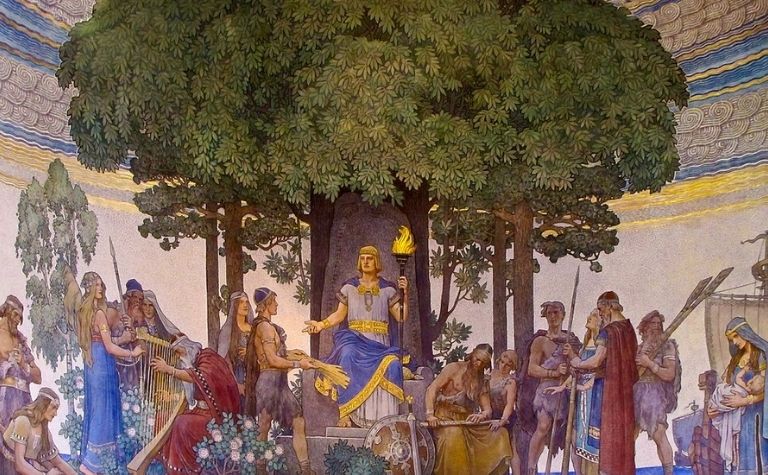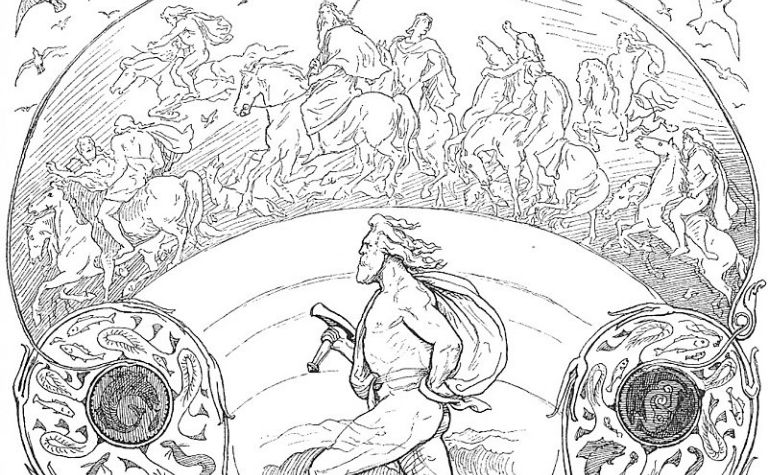Norse mythology is a rich collection of larger-than-life figures and compelling stories. It is also a source of iconic symbols and powerful imagery such as:
- Yggdrasil, the Norse tree of life
- Mjolnir, the mighty god of thunder, Thor’s hammer
- Sleipnir, Odin’s eight-legged horse
Not to be left out, however, is the rainbow bridge Bifrost, one of the most important icons in Norse mythology.
Not only does the Bifrost play a significant role in the maintenance of order among the nine realms of the universe, but it also figures prominently in the Ragnarok narrative, where that same order is threatened by the forces of chaos.
There is much to know about the Bifrost, and five key questions are answered below, so read on.
Also, see What Is the Meaning of the Valkyrie Symbol in Norse Mythology?

Why is it Called the Bifrost?
The Bifrost (roughly pronounced BIF-roast) bridge gets its name from the Old Norse word Bifrӧst, meaning the “shaking or trembling rainbow.”
The word is not only a reference to the Bifrost’s color scheme but also the delicate, fleeting nature of this mythological structure.
Many scholars believe that the original name of the Bifrost Bridge was actually Bilrӧst, from the Old Norse word bil (a short period of time) and carried the meaning of an “ephemeral colorful bridge.”
Either way, the fragile nature of this enchanted causeway between Asgard and Midgard is its most significant attribute.
There are actually other, lesser-known names for the Bifrost, including the Asa-Bridge and Asbru, which are both references not only to the builders of the bridge but also the fact that the Aesir gods are the only beings that are permitted to traverse the structure.
What Does the Bifrost Look Like?
As the only thoroughfare connecting Asgard, the realm of the Aesir gods, with Midgard, the human domain, the Bifrost serves a vital function in the context of cosmic order.
Often referred to as an enchanted rainbow bridge (although, by most accounts, there are only three colors in the Bifrost as opposed to the traditional seven in actual rainbows), the Bifrost is one of the most iconic images in Norse mythology.
By most accounts, the Aesirs used the elements of fire, air, and water to build this colossal yet ethereal structure. [1]
Built by the Aesir gods for their own exclusive use to travel back and forth between their world and humankind’s, this awe-inspiring structure has attributes that exude divine influence, including:
- Bifrost forms a perfect arch, and its immense length spans the entire sky
- It is flawless in every aspect of its craftsmanship and is a structure like no other
- So vast are its dimensions that the Aesir gods traverse the Bifrost on horseback as they travel back and forth between Asgard and Midgard
- Beneath the Bifrost lies a body of boiling water, and rather than traveling across the bridge like his fellow Aesirs, Thor’s preferred route to Midgard is by wading through its scalding depths
- Unlike a traditional rainbow that has six or seven colors, the Bifrost is described as having three brilliant colors
- According to Icelandic poet Snorri Sturluson’s Prose Edda, the red-colored element of the Bifrost is a line of intense flames that serves to deter the Aesir gods’ main enemy, the Jotunn (giants), from crossing the bridge [2]
Whether from near or afar, the Bifrost is a breathtaking and imposing sight. Its sheer scale alone makes it one of the centerpieces of the Norse universe, as it is reputedly visible from all nine realms.
With its constant red glow fueled by its eternal flames, the Bifrost is one of the most enduring of images not just from Norse mythology but throughout the history of storytelling.
Also, see Is Norse Mythology Norwegian? to learn more.
Why is the Bifrost Important?
Through the lens of Norse mythology, the universe consists of nine separate realms, each inhabited by a unique group of beings and representing a particular aspect of the Norse cosmos. [3]
These worlds are supported by the branches and roots of the Norse tree of life, Yggdrasil, and are known as:
- Asgard – the realm of the Aesir gods
- Alfheim – the realm of the bright elves
- Jotunheim – the realm of the giants (the Jotunn)
- Midgard – the realm of humankind
- Muspelheim (Muspell) – the realm of fire giants (the forces of chaos)
- Nidavellir – the realm of the dwarves
- Niflheim – the realm of ice and mist
- Svartalfheim – the realm of the black elves
- Vanaheim – the realm of the Vanir gods
With respect to the Bifrost, four of these realms play central roles in the rainbow bridge narrative, starting with the creator-creation relationship between the Aesir gods and humans that is the motivation behind the Bifrost’s construction in the first place.
Next, we will discuss the primary reasons why the Bifrost is important. [4]
Also, see Do the Irish Believe in Norse Gods? to learn more.

The Bifrost Connects Asgard and Midgard
According to Norse mythology, the Aesir gods are largely responsible for creating the majority of the universe, including the human race and their realm of Midgard.
To protect their fragile creations and keep an eye on their affairs, the Aesirs constructed the Bifrost as the only thoroughfare connecting Asgard and Midgard.
Whether on horseback, by chariot, or other means, only the Aesirs can travel along the Bifrost, and there are measures they put in place to ensure the bridge’s security (more on this later).
At least, that was the intention when it was built. As is so often the case in the Norse universe, fate would have it a different way.
The Bifrost was Built with Defensive Barriers Against Invasion
The construction of the enchanted rainbow bridge as a means of connecting Asgard and Midgard meant that the homeland of the Aesir gods would potentially be exposed to invasion by hostile forces, namely their mortal enemies, the giants.
For this reason, the Aesirs had the forethought to incorporate several layers of defenses into the construction of the Bifrost:
- Vigilantly standing guard over the rainbow bridge and monitoring those who traverse it is the mighty Aesir god Heimdall (more on him later)
- Of the three colored rays that make up its length, the red band glows hot with “burning fire” as deterrence against giants with designs on invading Asgard
The Vikings believed that all fates were predetermined and not even the most powerful of the Aesir gods, the all-father Odin, could alter them.
Thus, despite the robust measures taken by the Aesirs to secure the Bifrost, it was ultimately traversed (and destroyed in the process) by the fire giants en route to Asgard.
The Bifrost is Destroyed by the Fire Giants During Ragnarok
The Ragnarok narrative in Norse mythology is as compelling of an apocalyptic tale as there is in the history of storytelling.
The destruction of the cosmos and nearly every living thing within it (gods and giants included) and its rebirth as a universe completely free from chaos is a central theme running throughout many Norse myths and legends.
Such is certainly the case with the Bifrost.
Although it was constructed with the primary objective of connecting Asgard and Midgard, its use as a celestial causeway is ultimately turned against its creators as the fire giants of Muspelheim led by the fearsome Surtr cross the Bifrost to attack the Aesir gods on their home turf during the events of Ragnarok.
As the narrative goes, the rainbow bridge crumbles under the weight of hordes of fire giants marching across its fragile span, and Asgard is completely laid to waste in the fighting that ensues.
And, as has been foretold by fate, most of the Aesirs, including the all-father Odin and the god of thunder Thor, meet their demise during the apocalyptic battle to end all battles.

Who Protects the Bifrost?
From the outset, the Aesir gods knew that by constructing the Bifrost to connect their world with that of the humans, they would be exposing Asgard to the threat of invasion by their enemies.
With this reality in mind, they assigned one of their own to stand guard over the rainbow bridge from a post on the Asgard side.
Heimdall – Guardian of the Bifrost
The Aesir tasked with this grave duty was Heimdall (pronounced “HAME-doll”), the son of Odin who was born to nine mothers (all sea deities).
In Old Norse, his name means “the one who illuminates the world” and is a tribute not only to his unparalleled wisdom but also to his virtue. [5]
Known by nicknames including “gold tooth” and the “bright one,” the dashingly handsome Heimdall was blessed with many incredible attributes that made him the perfect choice for guarding the Bifrost and serving as Asgard’s dutiful sentry. These divine qualities include:
- Eyesight – Heimdall’s vision is so acute that he can see objects hundreds of miles away clearly and can observe blades of grass growing; his vision is equally sharp in broad daylight or the pitch black of night
- Hearing – so sharp is Heimdall’s sense of hearing that he can hear the wool growing on a sheep
- Strength and stamina – Heimdall requires minimal rest and can function at the peak of his abilities with less sleep than a bird would need
Aside from his physical and sensory gifts, Heimdall is known for the ability to bestow wisdom and decorum to others and is therefore viewed as an ally and patron to humankind.
It is, therefore, fitting that he alone watches over the Bifrost, the bridge between Asgard and Midgard.
As with so many divine figures in Norse mythology, Heimdall’s most memorable acts occur during the events of Ragnarok, and they can be summarized thusly:
- It is Heimdall who stands ever vigilant, not only watching for signs of any potential breaches of the Bifrost but also for the telltale indications that Ragnarok has begun
- Among his many talents, Heimdall is blessed with the gift of foresight and is, therefore, the first of the Aesirs to recognize when things are amiss
- Upon observing the gathering of enemy forces at the plains of Vigrid, he recognizes the assembly as one of the precursors of Ragnarok
- Heimdall, without hesitation, sounded the alarm for all Aesirs to hear by blowing the enchanted Gjallarhorn (Old Norse for “yelling horn”)
Like so many of his Aesir peers, Heimdall’s destiny had been foretold prior to the events of Ragnarok.
In the final confrontation between the Aesir gods and the Jotnar, Heimdall faced off in a one-on-one battle with the trickster god Loki, and they each died by the other’s hand. [6]
Can Thor Summon the Bifrost?
The far-reaching impact of the Bifrost narrative is not limited to Norse mythology in its traditional sense.
It also extends to modern-day storytelling and has found new life as a powerful plot mechanism in the ever-popular MCU (Marvel Cinematic Universe) media franchise where Thor, Odin, Loki, and other familiar figures from Norse mythology (even Heimdall) once again take center stage.
What Role Does the Bifrost Play in the MCU?
In the Thor movies, the Bifrost assumes a familiar role as a mode of transport between different realms within the universe.
But whereas in Norse mythology, the Bifrost was an enchanted bridge that connected Asgard with Midgard, in the MCU, it takes on a far greater and more powerful role.
No longer a mere bridge, the Bifrost is a teleportation vehicle that enables anyone or anything to be instantly transported from Asgard to any destination in the universe and vice-versa. [7]
Its incredible powers can be summoned in several ways:
- Bifrost can be called upon through dark magic
- Heimdall is still its primary guardian and can activate the Bifrost
- The all-father Odin can energize the Bifrost with his magical spear Gungnir
- Last but certainly not least, the god of thunder Thor can summon the Bifrost with his enchanted weapon Stormbreaker (which replaced the destroyed Mjolnir)
In both its ancient Norse mythology and modern MCU cinematic iterations, the Bifrost is the stuff of imagination.
But according to one of the greatest scientific minds that ever lived, Einstien, there may be a thread of truth to the rainbow bridge.
Albert Einstein and the Bifrost
Among the many scientific theories he advanced, Albert Einstein (along with fellow physicist Nathan Rosen) proposed the existence of wormholes that could theoretically defy the constraints of time and distance and transport objects across vast expanses of the universe.
In essence, this is the very purpose served by the Bifrost in the MCU Thor films. Imagine that.
Final Thoughts
The Bifrost is a vital element in Norse mythology as a means of connecting the realm of the gods with that of their creation, humankind.
References:
[1] Source
[2] Source
[3] Source
[4] Source
[5] Source
[6] Source
[7] Source
